Business Report on Sustainable Operations in Dog Global Manufacturing
VerifiedAdded on 2022/03/02
|10
|3502
|23
AI Summary
More than 54,500 tonnes of garbage is generated each year by the disposal of 630 million dog toys. Obsolete products have limited life spans, thus manufacturers design obsolescence. Dog toys with just a restricted usable life are sold by pet enterprises to encourage a recurrent purchase, which in turn promotes consumption. Which, in turn, causes millions of such toys to be thrown away each year? Toys like this one are designed to keep thousands of dog toys out of landfills
Contribute Materials
Your contribution can guide someone’s learning journey. Share your
documents today.
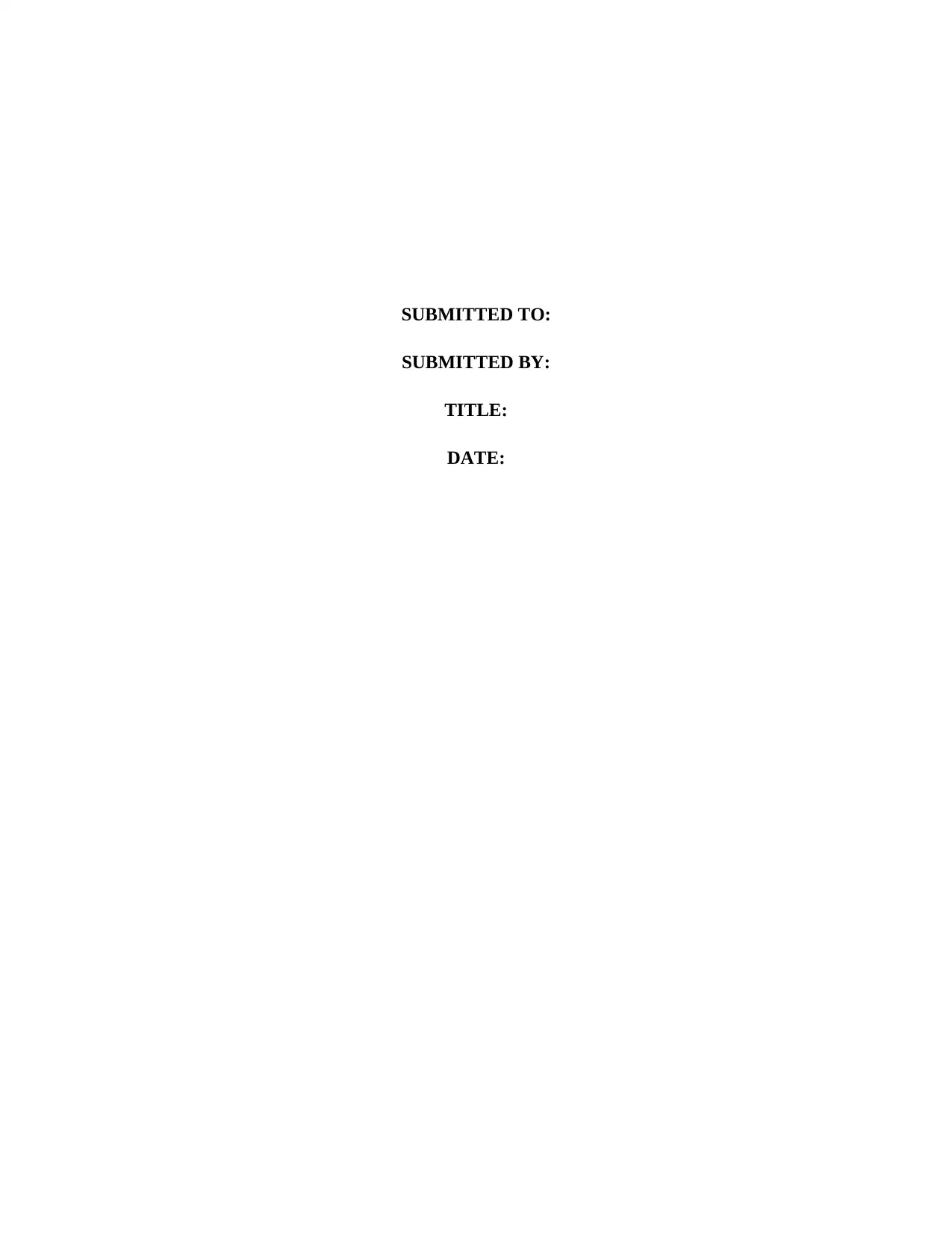
SUBMITTED TO:
SUBMITTED BY:
TITLE:
DATE:
SUBMITTED BY:
TITLE:
DATE:
Secure Best Marks with AI Grader
Need help grading? Try our AI Grader for instant feedback on your assignments.
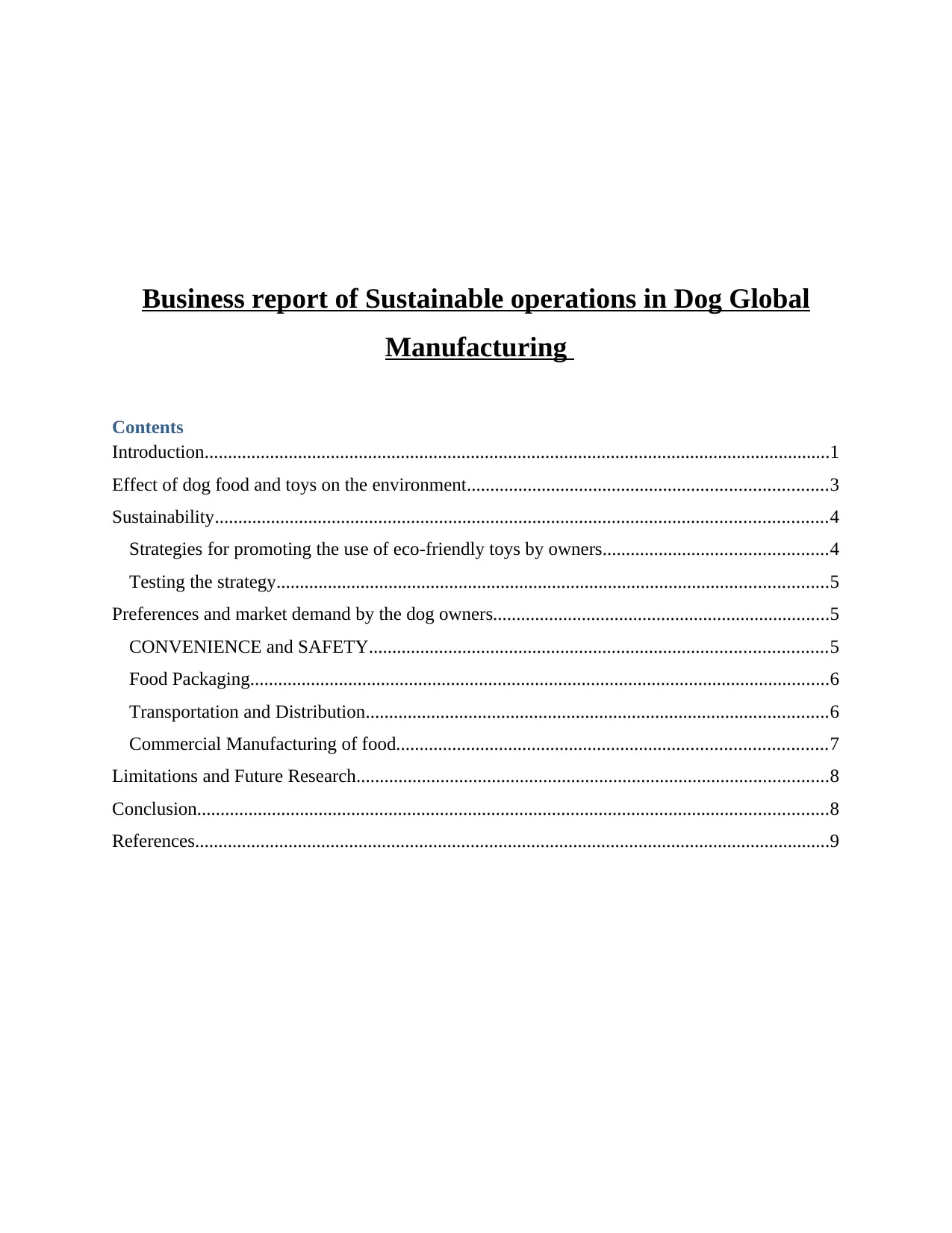
Business report of Sustainable operations in Dog Global
Manufacturing
Contents
Introduction......................................................................................................................................1
Effect of dog food and toys on the environment.............................................................................3
Sustainability...................................................................................................................................4
Strategies for promoting the use of eco-friendly toys by owners................................................4
Testing the strategy......................................................................................................................5
Preferences and market demand by the dog owners........................................................................5
CONVENIENCE and SAFETY..................................................................................................5
Food Packaging............................................................................................................................6
Transportation and Distribution...................................................................................................6
Commercial Manufacturing of food............................................................................................7
Limitations and Future Research.....................................................................................................8
Conclusion.......................................................................................................................................8
References........................................................................................................................................9
Manufacturing
Contents
Introduction......................................................................................................................................1
Effect of dog food and toys on the environment.............................................................................3
Sustainability...................................................................................................................................4
Strategies for promoting the use of eco-friendly toys by owners................................................4
Testing the strategy......................................................................................................................5
Preferences and market demand by the dog owners........................................................................5
CONVENIENCE and SAFETY..................................................................................................5
Food Packaging............................................................................................................................6
Transportation and Distribution...................................................................................................6
Commercial Manufacturing of food............................................................................................7
Limitations and Future Research.....................................................................................................8
Conclusion.......................................................................................................................................8
References........................................................................................................................................9
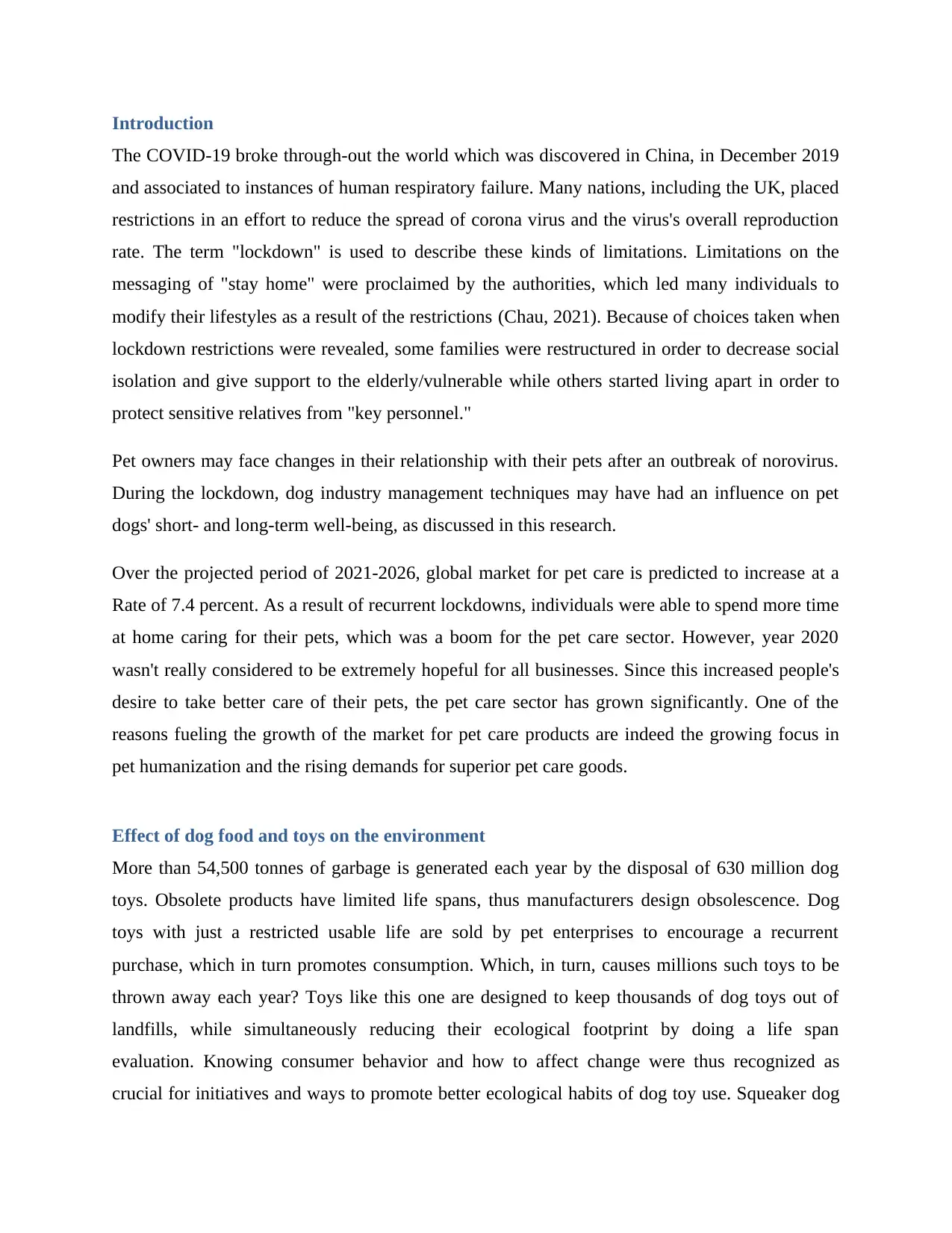
Introduction
The COVID-19 broke through-out the world which was discovered in China, in December 2019
and associated to instances of human respiratory failure. Many nations, including the UK, placed
restrictions in an effort to reduce the spread of corona virus and the virus's overall reproduction
rate. The term "lockdown" is used to describe these kinds of limitations. Limitations on the
messaging of "stay home" were proclaimed by the authorities, which led many individuals to
modify their lifestyles as a result of the restrictions (Chau, 2021). Because of choices taken when
lockdown restrictions were revealed, some families were restructured in order to decrease social
isolation and give support to the elderly/vulnerable while others started living apart in order to
protect sensitive relatives from "key personnel."
Pet owners may face changes in their relationship with their pets after an outbreak of norovirus.
During the lockdown, dog industry management techniques may have had an influence on pet
dogs' short- and long-term well-being, as discussed in this research.
Over the projected period of 2021-2026, global market for pet care is predicted to increase at a
Rate of 7.4 percent. As a result of recurrent lockdowns, individuals were able to spend more time
at home caring for their pets, which was a boom for the pet care sector. However, year 2020
wasn't really considered to be extremely hopeful for all businesses. Since this increased people's
desire to take better care of their pets, the pet care sector has grown significantly. One of the
reasons fueling the growth of the market for pet care products are indeed the growing focus in
pet humanization and the rising demands for superior pet care goods.
Effect of dog food and toys on the environment
More than 54,500 tonnes of garbage is generated each year by the disposal of 630 million dog
toys. Obsolete products have limited life spans, thus manufacturers design obsolescence. Dog
toys with just a restricted usable life are sold by pet enterprises to encourage a recurrent
purchase, which in turn promotes consumption. Which, in turn, causes millions such toys to be
thrown away each year? Toys like this one are designed to keep thousands of dog toys out of
landfills, while simultaneously reducing their ecological footprint by doing a life span
evaluation. Knowing consumer behavior and how to affect change were thus recognized as
crucial for initiatives and ways to promote better ecological habits of dog toy use. Squeaker dog
The COVID-19 broke through-out the world which was discovered in China, in December 2019
and associated to instances of human respiratory failure. Many nations, including the UK, placed
restrictions in an effort to reduce the spread of corona virus and the virus's overall reproduction
rate. The term "lockdown" is used to describe these kinds of limitations. Limitations on the
messaging of "stay home" were proclaimed by the authorities, which led many individuals to
modify their lifestyles as a result of the restrictions (Chau, 2021). Because of choices taken when
lockdown restrictions were revealed, some families were restructured in order to decrease social
isolation and give support to the elderly/vulnerable while others started living apart in order to
protect sensitive relatives from "key personnel."
Pet owners may face changes in their relationship with their pets after an outbreak of norovirus.
During the lockdown, dog industry management techniques may have had an influence on pet
dogs' short- and long-term well-being, as discussed in this research.
Over the projected period of 2021-2026, global market for pet care is predicted to increase at a
Rate of 7.4 percent. As a result of recurrent lockdowns, individuals were able to spend more time
at home caring for their pets, which was a boom for the pet care sector. However, year 2020
wasn't really considered to be extremely hopeful for all businesses. Since this increased people's
desire to take better care of their pets, the pet care sector has grown significantly. One of the
reasons fueling the growth of the market for pet care products are indeed the growing focus in
pet humanization and the rising demands for superior pet care goods.
Effect of dog food and toys on the environment
More than 54,500 tonnes of garbage is generated each year by the disposal of 630 million dog
toys. Obsolete products have limited life spans, thus manufacturers design obsolescence. Dog
toys with just a restricted usable life are sold by pet enterprises to encourage a recurrent
purchase, which in turn promotes consumption. Which, in turn, causes millions such toys to be
thrown away each year? Toys like this one are designed to keep thousands of dog toys out of
landfills, while simultaneously reducing their ecological footprint by doing a life span
evaluation. Knowing consumer behavior and how to affect change were thus recognized as
crucial for initiatives and ways to promote better ecological habits of dog toy use. Squeaker dog
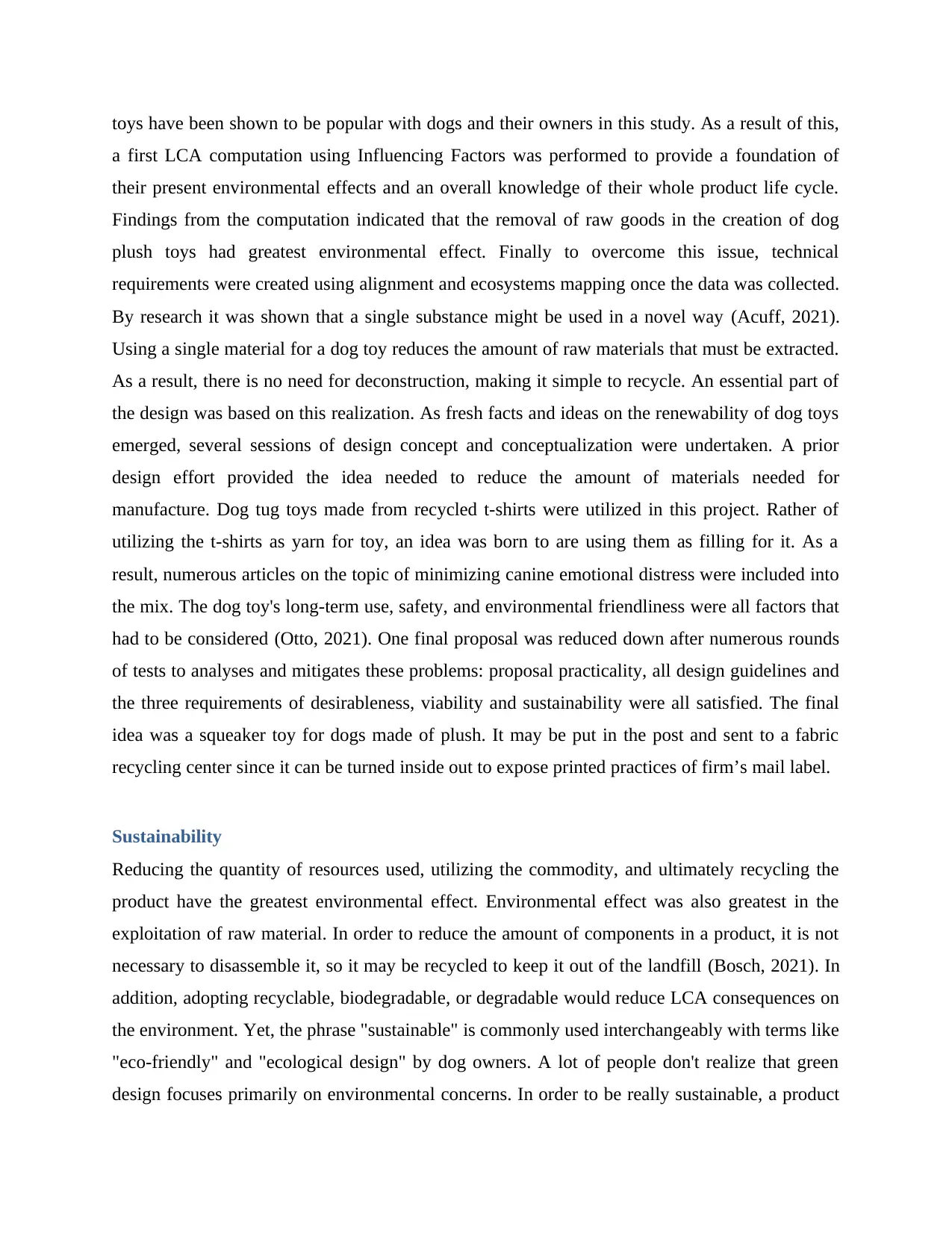
toys have been shown to be popular with dogs and their owners in this study. As a result of this,
a first LCA computation using Influencing Factors was performed to provide a foundation of
their present environmental effects and an overall knowledge of their whole product life cycle.
Findings from the computation indicated that the removal of raw goods in the creation of dog
plush toys had greatest environmental effect. Finally to overcome this issue, technical
requirements were created using alignment and ecosystems mapping once the data was collected.
By research it was shown that a single substance might be used in a novel way (Acuff, 2021).
Using a single material for a dog toy reduces the amount of raw materials that must be extracted.
As a result, there is no need for deconstruction, making it simple to recycle. An essential part of
the design was based on this realization. As fresh facts and ideas on the renewability of dog toys
emerged, several sessions of design concept and conceptualization were undertaken. A prior
design effort provided the idea needed to reduce the amount of materials needed for
manufacture. Dog tug toys made from recycled t-shirts were utilized in this project. Rather of
utilizing the t-shirts as yarn for toy, an idea was born to are using them as filling for it. As a
result, numerous articles on the topic of minimizing canine emotional distress were included into
the mix. The dog toy's long-term use, safety, and environmental friendliness were all factors that
had to be considered (Otto, 2021). One final proposal was reduced down after numerous rounds
of tests to analyses and mitigates these problems: proposal practicality, all design guidelines and
the three requirements of desirableness, viability and sustainability were all satisfied. The final
idea was a squeaker toy for dogs made of plush. It may be put in the post and sent to a fabric
recycling center since it can be turned inside out to expose printed practices of firm’s mail label.
Sustainability
Reducing the quantity of resources used, utilizing the commodity, and ultimately recycling the
product have the greatest environmental effect. Environmental effect was also greatest in the
exploitation of raw material. In order to reduce the amount of components in a product, it is not
necessary to disassemble it, so it may be recycled to keep it out of the landfill (Bosch, 2021). In
addition, adopting recyclable, biodegradable, or degradable would reduce LCA consequences on
the environment. Yet, the phrase "sustainable" is commonly used interchangeably with terms like
"eco-friendly" and "ecological design" by dog owners. A lot of people don't realize that green
design focuses primarily on environmental concerns. In order to be really sustainable, a product
a first LCA computation using Influencing Factors was performed to provide a foundation of
their present environmental effects and an overall knowledge of their whole product life cycle.
Findings from the computation indicated that the removal of raw goods in the creation of dog
plush toys had greatest environmental effect. Finally to overcome this issue, technical
requirements were created using alignment and ecosystems mapping once the data was collected.
By research it was shown that a single substance might be used in a novel way (Acuff, 2021).
Using a single material for a dog toy reduces the amount of raw materials that must be extracted.
As a result, there is no need for deconstruction, making it simple to recycle. An essential part of
the design was based on this realization. As fresh facts and ideas on the renewability of dog toys
emerged, several sessions of design concept and conceptualization were undertaken. A prior
design effort provided the idea needed to reduce the amount of materials needed for
manufacture. Dog tug toys made from recycled t-shirts were utilized in this project. Rather of
utilizing the t-shirts as yarn for toy, an idea was born to are using them as filling for it. As a
result, numerous articles on the topic of minimizing canine emotional distress were included into
the mix. The dog toy's long-term use, safety, and environmental friendliness were all factors that
had to be considered (Otto, 2021). One final proposal was reduced down after numerous rounds
of tests to analyses and mitigates these problems: proposal practicality, all design guidelines and
the three requirements of desirableness, viability and sustainability were all satisfied. The final
idea was a squeaker toy for dogs made of plush. It may be put in the post and sent to a fabric
recycling center since it can be turned inside out to expose printed practices of firm’s mail label.
Sustainability
Reducing the quantity of resources used, utilizing the commodity, and ultimately recycling the
product have the greatest environmental effect. Environmental effect was also greatest in the
exploitation of raw material. In order to reduce the amount of components in a product, it is not
necessary to disassemble it, so it may be recycled to keep it out of the landfill (Bosch, 2021). In
addition, adopting recyclable, biodegradable, or degradable would reduce LCA consequences on
the environment. Yet, the phrase "sustainable" is commonly used interchangeably with terms like
"eco-friendly" and "ecological design" by dog owners. A lot of people don't realize that green
design focuses primarily on environmental concerns. In order to be really sustainable, a product
Secure Best Marks with AI Grader
Need help grading? Try our AI Grader for instant feedback on your assignments.
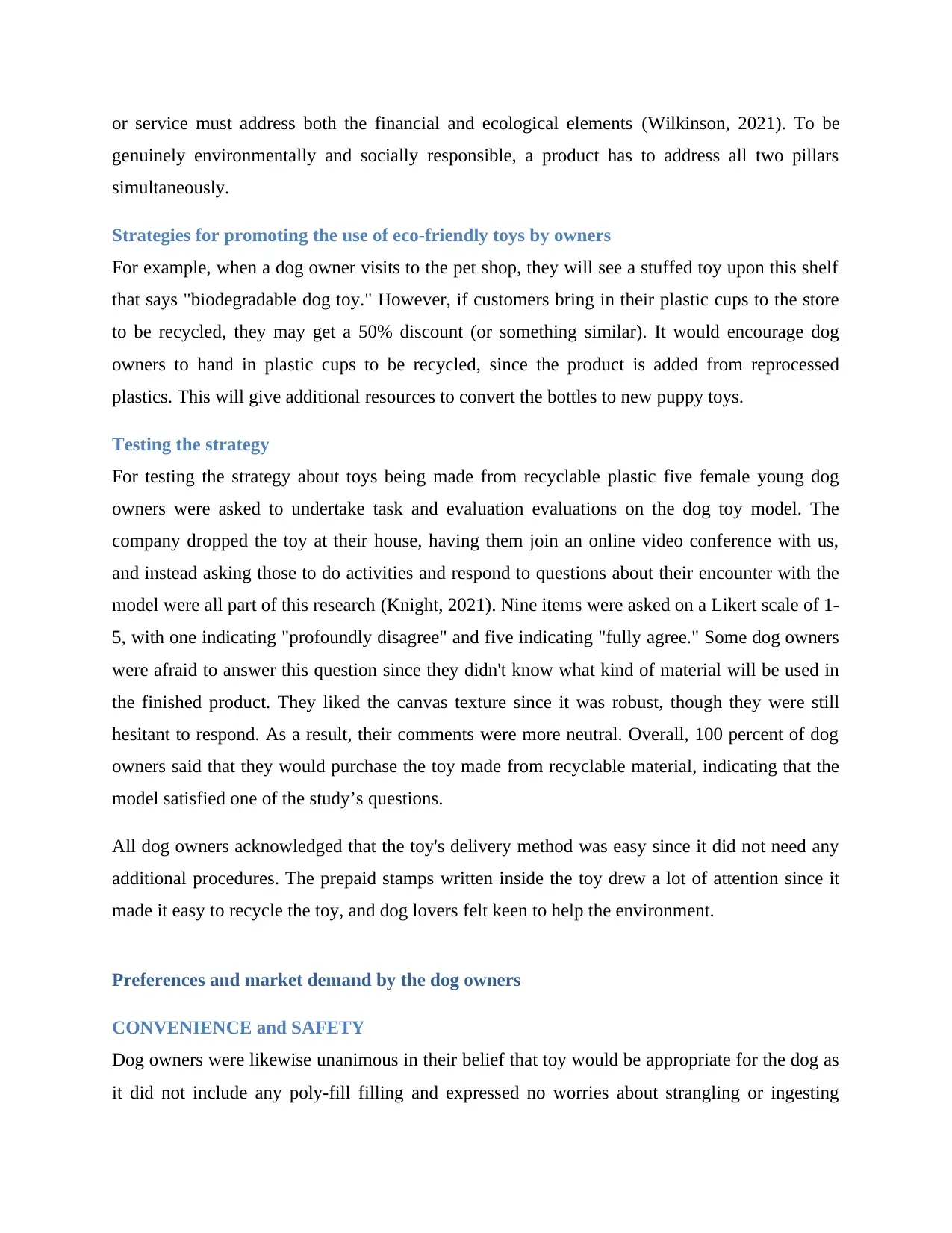
or service must address both the financial and ecological elements (Wilkinson, 2021). To be
genuinely environmentally and socially responsible, a product has to address all two pillars
simultaneously.
Strategies for promoting the use of eco-friendly toys by owners
For example, when a dog owner visits to the pet shop, they will see a stuffed toy upon this shelf
that says "biodegradable dog toy." However, if customers bring in their plastic cups to the store
to be recycled, they may get a 50% discount (or something similar). It would encourage dog
owners to hand in plastic cups to be recycled, since the product is added from reprocessed
plastics. This will give additional resources to convert the bottles to new puppy toys.
Testing the strategy
For testing the strategy about toys being made from recyclable plastic five female young dog
owners were asked to undertake task and evaluation evaluations on the dog toy model. The
company dropped the toy at their house, having them join an online video conference with us,
and instead asking those to do activities and respond to questions about their encounter with the
model were all part of this research (Knight, 2021). Nine items were asked on a Likert scale of 1-
5, with one indicating "profoundly disagree" and five indicating "fully agree." Some dog owners
were afraid to answer this question since they didn't know what kind of material will be used in
the finished product. They liked the canvas texture since it was robust, though they were still
hesitant to respond. As a result, their comments were more neutral. Overall, 100 percent of dog
owners said that they would purchase the toy made from recyclable material, indicating that the
model satisfied one of the study’s questions.
All dog owners acknowledged that the toy's delivery method was easy since it did not need any
additional procedures. The prepaid stamps written inside the toy drew a lot of attention since it
made it easy to recycle the toy, and dog lovers felt keen to help the environment.
Preferences and market demand by the dog owners
CONVENIENCE and SAFETY
Dog owners were likewise unanimous in their belief that toy would be appropriate for the dog as
it did not include any poly-fill filling and expressed no worries about strangling or ingesting
genuinely environmentally and socially responsible, a product has to address all two pillars
simultaneously.
Strategies for promoting the use of eco-friendly toys by owners
For example, when a dog owner visits to the pet shop, they will see a stuffed toy upon this shelf
that says "biodegradable dog toy." However, if customers bring in their plastic cups to the store
to be recycled, they may get a 50% discount (or something similar). It would encourage dog
owners to hand in plastic cups to be recycled, since the product is added from reprocessed
plastics. This will give additional resources to convert the bottles to new puppy toys.
Testing the strategy
For testing the strategy about toys being made from recyclable plastic five female young dog
owners were asked to undertake task and evaluation evaluations on the dog toy model. The
company dropped the toy at their house, having them join an online video conference with us,
and instead asking those to do activities and respond to questions about their encounter with the
model were all part of this research (Knight, 2021). Nine items were asked on a Likert scale of 1-
5, with one indicating "profoundly disagree" and five indicating "fully agree." Some dog owners
were afraid to answer this question since they didn't know what kind of material will be used in
the finished product. They liked the canvas texture since it was robust, though they were still
hesitant to respond. As a result, their comments were more neutral. Overall, 100 percent of dog
owners said that they would purchase the toy made from recyclable material, indicating that the
model satisfied one of the study’s questions.
All dog owners acknowledged that the toy's delivery method was easy since it did not need any
additional procedures. The prepaid stamps written inside the toy drew a lot of attention since it
made it easy to recycle the toy, and dog lovers felt keen to help the environment.
Preferences and market demand by the dog owners
CONVENIENCE and SAFETY
Dog owners were likewise unanimous in their belief that toy would be appropriate for the dog as
it did not include any poly-fill filling and expressed no worries about strangling or ingesting
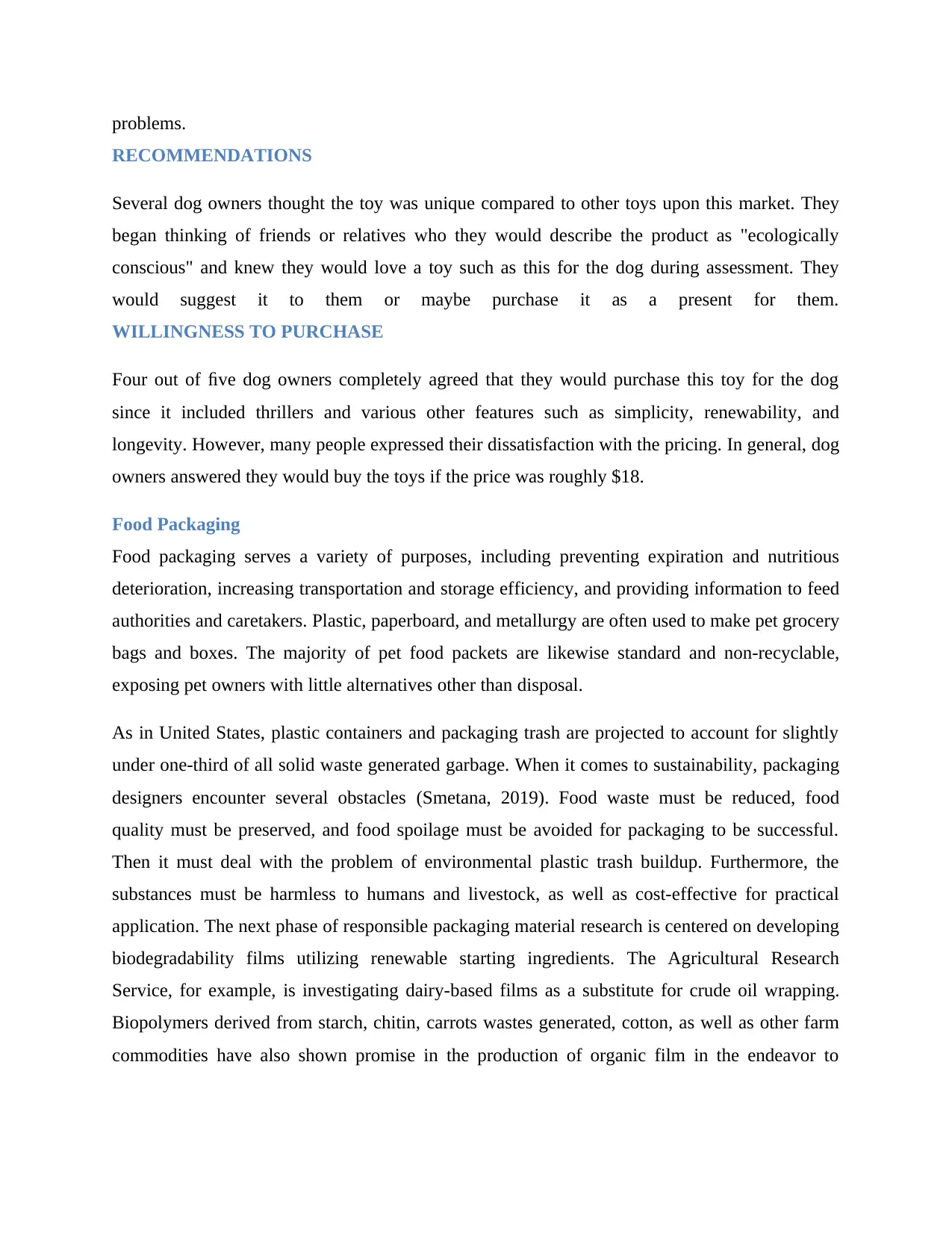
problems.
RECOMMENDATIONS
Several dog owners thought the toy was unique compared to other toys upon this market. They
began thinking of friends or relatives who they would describe the product as "ecologically
conscious" and knew they would love a toy such as this for the dog during assessment. They
would suggest it to them or maybe purchase it as a present for them.
WILLINGNESS TO PURCHASE
Four out of five dog owners completely agreed that they would purchase this toy for the dog
since it included thrillers and various other features such as simplicity, renewability, and
longevity. However, many people expressed their dissatisfaction with the pricing. In general, dog
owners answered they would buy the toys if the price was roughly $18.
Food Packaging
Food packaging serves a variety of purposes, including preventing expiration and nutritious
deterioration, increasing transportation and storage efficiency, and providing information to feed
authorities and caretakers. Plastic, paperboard, and metallurgy are often used to make pet grocery
bags and boxes. The majority of pet food packets are likewise standard and non-recyclable,
exposing pet owners with little alternatives other than disposal.
As in United States, plastic containers and packaging trash are projected to account for slightly
under one-third of all solid waste generated garbage. When it comes to sustainability, packaging
designers encounter several obstacles (Smetana, 2019). Food waste must be reduced, food
quality must be preserved, and food spoilage must be avoided for packaging to be successful.
Then it must deal with the problem of environmental plastic trash buildup. Furthermore, the
substances must be harmless to humans and livestock, as well as cost-effective for practical
application. The next phase of responsible packaging material research is centered on developing
biodegradability films utilizing renewable starting ingredients. The Agricultural Research
Service, for example, is investigating dairy-based films as a substitute for crude oil wrapping.
Biopolymers derived from starch, chitin, carrots wastes generated, cotton, as well as other farm
commodities have also shown promise in the production of organic film in the endeavor to
RECOMMENDATIONS
Several dog owners thought the toy was unique compared to other toys upon this market. They
began thinking of friends or relatives who they would describe the product as "ecologically
conscious" and knew they would love a toy such as this for the dog during assessment. They
would suggest it to them or maybe purchase it as a present for them.
WILLINGNESS TO PURCHASE
Four out of five dog owners completely agreed that they would purchase this toy for the dog
since it included thrillers and various other features such as simplicity, renewability, and
longevity. However, many people expressed their dissatisfaction with the pricing. In general, dog
owners answered they would buy the toys if the price was roughly $18.
Food Packaging
Food packaging serves a variety of purposes, including preventing expiration and nutritious
deterioration, increasing transportation and storage efficiency, and providing information to feed
authorities and caretakers. Plastic, paperboard, and metallurgy are often used to make pet grocery
bags and boxes. The majority of pet food packets are likewise standard and non-recyclable,
exposing pet owners with little alternatives other than disposal.
As in United States, plastic containers and packaging trash are projected to account for slightly
under one-third of all solid waste generated garbage. When it comes to sustainability, packaging
designers encounter several obstacles (Smetana, 2019). Food waste must be reduced, food
quality must be preserved, and food spoilage must be avoided for packaging to be successful.
Then it must deal with the problem of environmental plastic trash buildup. Furthermore, the
substances must be harmless to humans and livestock, as well as cost-effective for practical
application. The next phase of responsible packaging material research is centered on developing
biodegradability films utilizing renewable starting ingredients. The Agricultural Research
Service, for example, is investigating dairy-based films as a substitute for crude oil wrapping.
Biopolymers derived from starch, chitin, carrots wastes generated, cotton, as well as other farm
commodities have also shown promise in the production of organic film in the endeavor to
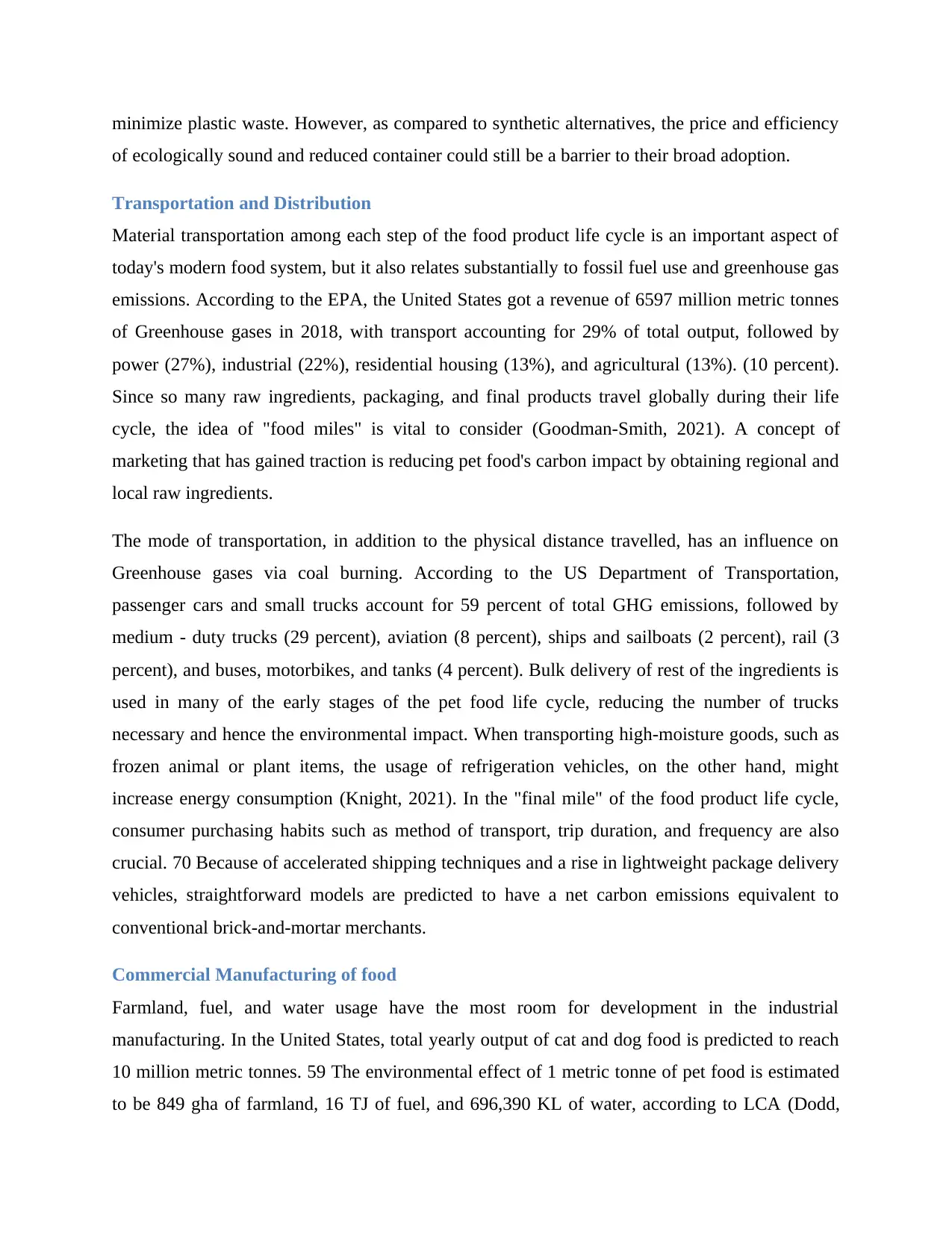
minimize plastic waste. However, as compared to synthetic alternatives, the price and efficiency
of ecologically sound and reduced container could still be a barrier to their broad adoption.
Transportation and Distribution
Material transportation among each step of the food product life cycle is an important aspect of
today's modern food system, but it also relates substantially to fossil fuel use and greenhouse gas
emissions. According to the EPA, the United States got a revenue of 6597 million metric tonnes
of Greenhouse gases in 2018, with transport accounting for 29% of total output, followed by
power (27%), industrial (22%), residential housing (13%), and agricultural (13%). (10 percent).
Since so many raw ingredients, packaging, and final products travel globally during their life
cycle, the idea of "food miles" is vital to consider (Goodman-Smith, 2021). A concept of
marketing that has gained traction is reducing pet food's carbon impact by obtaining regional and
local raw ingredients.
The mode of transportation, in addition to the physical distance travelled, has an influence on
Greenhouse gases via coal burning. According to the US Department of Transportation,
passenger cars and small trucks account for 59 percent of total GHG emissions, followed by
medium - duty trucks (29 percent), aviation (8 percent), ships and sailboats (2 percent), rail (3
percent), and buses, motorbikes, and tanks (4 percent). Bulk delivery of rest of the ingredients is
used in many of the early stages of the pet food life cycle, reducing the number of trucks
necessary and hence the environmental impact. When transporting high-moisture goods, such as
frozen animal or plant items, the usage of refrigeration vehicles, on the other hand, might
increase energy consumption (Knight, 2021). In the "final mile" of the food product life cycle,
consumer purchasing habits such as method of transport, trip duration, and frequency are also
crucial. 70 Because of accelerated shipping techniques and a rise in lightweight package delivery
vehicles, straightforward models are predicted to have a net carbon emissions equivalent to
conventional brick-and-mortar merchants.
Commercial Manufacturing of food
Farmland, fuel, and water usage have the most room for development in the industrial
manufacturing. In the United States, total yearly output of cat and dog food is predicted to reach
10 million metric tonnes. 59 The environmental effect of 1 metric tonne of pet food is estimated
to be 849 gha of farmland, 16 TJ of fuel, and 696,390 KL of water, according to LCA (Dodd,
of ecologically sound and reduced container could still be a barrier to their broad adoption.
Transportation and Distribution
Material transportation among each step of the food product life cycle is an important aspect of
today's modern food system, but it also relates substantially to fossil fuel use and greenhouse gas
emissions. According to the EPA, the United States got a revenue of 6597 million metric tonnes
of Greenhouse gases in 2018, with transport accounting for 29% of total output, followed by
power (27%), industrial (22%), residential housing (13%), and agricultural (13%). (10 percent).
Since so many raw ingredients, packaging, and final products travel globally during their life
cycle, the idea of "food miles" is vital to consider (Goodman-Smith, 2021). A concept of
marketing that has gained traction is reducing pet food's carbon impact by obtaining regional and
local raw ingredients.
The mode of transportation, in addition to the physical distance travelled, has an influence on
Greenhouse gases via coal burning. According to the US Department of Transportation,
passenger cars and small trucks account for 59 percent of total GHG emissions, followed by
medium - duty trucks (29 percent), aviation (8 percent), ships and sailboats (2 percent), rail (3
percent), and buses, motorbikes, and tanks (4 percent). Bulk delivery of rest of the ingredients is
used in many of the early stages of the pet food life cycle, reducing the number of trucks
necessary and hence the environmental impact. When transporting high-moisture goods, such as
frozen animal or plant items, the usage of refrigeration vehicles, on the other hand, might
increase energy consumption (Knight, 2021). In the "final mile" of the food product life cycle,
consumer purchasing habits such as method of transport, trip duration, and frequency are also
crucial. 70 Because of accelerated shipping techniques and a rise in lightweight package delivery
vehicles, straightforward models are predicted to have a net carbon emissions equivalent to
conventional brick-and-mortar merchants.
Commercial Manufacturing of food
Farmland, fuel, and water usage have the most room for development in the industrial
manufacturing. In the United States, total yearly output of cat and dog food is predicted to reach
10 million metric tonnes. 59 The environmental effect of 1 metric tonne of pet food is estimated
to be 849 gha of farmland, 16 TJ of fuel, and 696,390 KL of water, according to LCA (Dodd,
Paraphrase This Document
Need a fresh take? Get an instant paraphrase of this document with our AI Paraphraser
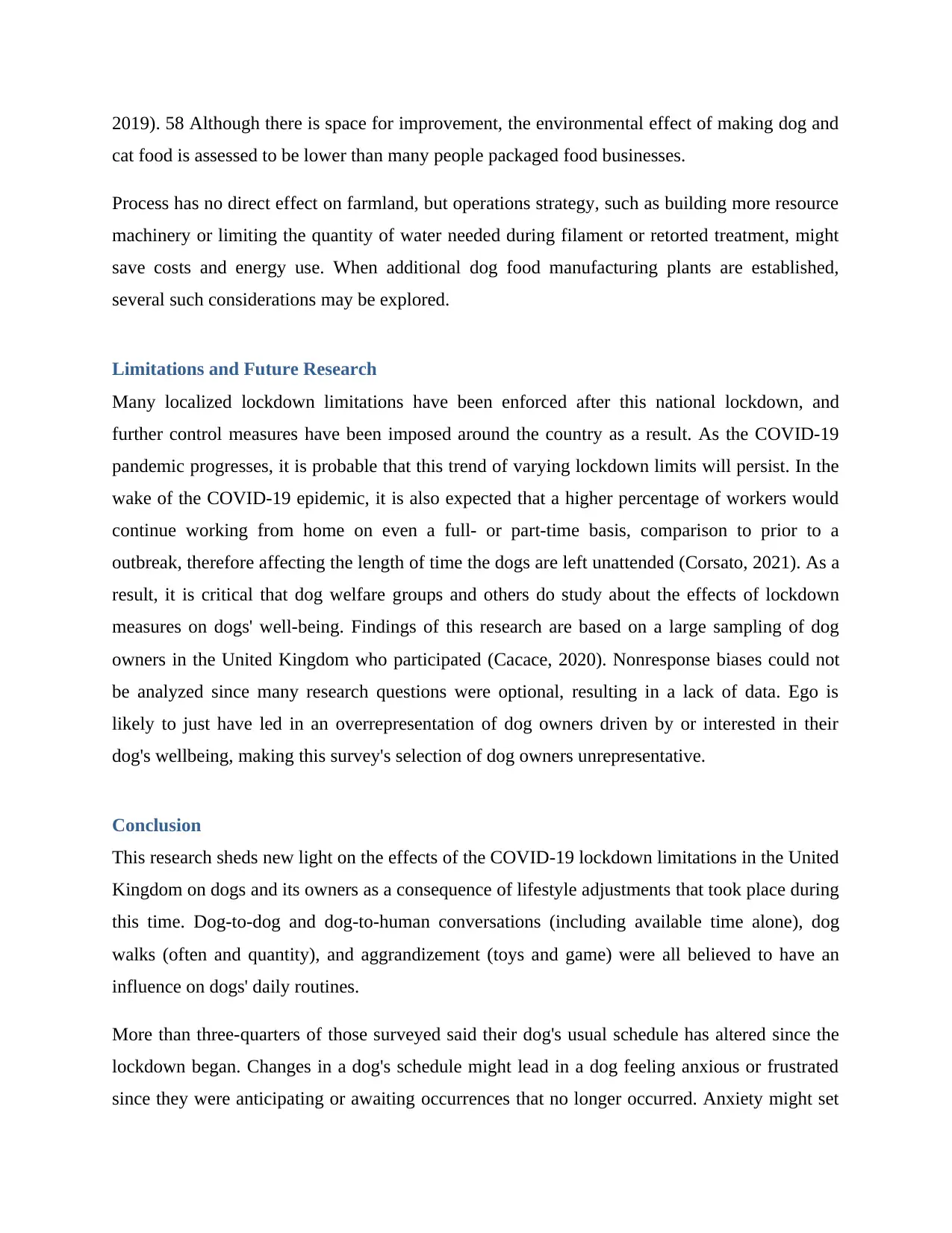
2019). 58 Although there is space for improvement, the environmental effect of making dog and
cat food is assessed to be lower than many people packaged food businesses.
Process has no direct effect on farmland, but operations strategy, such as building more resource
machinery or limiting the quantity of water needed during filament or retorted treatment, might
save costs and energy use. When additional dog food manufacturing plants are established,
several such considerations may be explored.
Limitations and Future Research
Many localized lockdown limitations have been enforced after this national lockdown, and
further control measures have been imposed around the country as a result. As the COVID-19
pandemic progresses, it is probable that this trend of varying lockdown limits will persist. In the
wake of the COVID-19 epidemic, it is also expected that a higher percentage of workers would
continue working from home on even a full- or part-time basis, comparison to prior to a
outbreak, therefore affecting the length of time the dogs are left unattended (Corsato, 2021). As a
result, it is critical that dog welfare groups and others do study about the effects of lockdown
measures on dogs' well-being. Findings of this research are based on a large sampling of dog
owners in the United Kingdom who participated (Cacace, 2020). Nonresponse biases could not
be analyzed since many research questions were optional, resulting in a lack of data. Ego is
likely to just have led in an overrepresentation of dog owners driven by or interested in their
dog's wellbeing, making this survey's selection of dog owners unrepresentative.
Conclusion
This research sheds new light on the effects of the COVID-19 lockdown limitations in the United
Kingdom on dogs and its owners as a consequence of lifestyle adjustments that took place during
this time. Dog-to-dog and dog-to-human conversations (including available time alone), dog
walks (often and quantity), and aggrandizement (toys and game) were all believed to have an
influence on dogs' daily routines.
More than three-quarters of those surveyed said their dog's usual schedule has altered since the
lockdown began. Changes in a dog's schedule might lead in a dog feeling anxious or frustrated
since they were anticipating or awaiting occurrences that no longer occurred. Anxiety might set
cat food is assessed to be lower than many people packaged food businesses.
Process has no direct effect on farmland, but operations strategy, such as building more resource
machinery or limiting the quantity of water needed during filament or retorted treatment, might
save costs and energy use. When additional dog food manufacturing plants are established,
several such considerations may be explored.
Limitations and Future Research
Many localized lockdown limitations have been enforced after this national lockdown, and
further control measures have been imposed around the country as a result. As the COVID-19
pandemic progresses, it is probable that this trend of varying lockdown limits will persist. In the
wake of the COVID-19 epidemic, it is also expected that a higher percentage of workers would
continue working from home on even a full- or part-time basis, comparison to prior to a
outbreak, therefore affecting the length of time the dogs are left unattended (Corsato, 2021). As a
result, it is critical that dog welfare groups and others do study about the effects of lockdown
measures on dogs' well-being. Findings of this research are based on a large sampling of dog
owners in the United Kingdom who participated (Cacace, 2020). Nonresponse biases could not
be analyzed since many research questions were optional, resulting in a lack of data. Ego is
likely to just have led in an overrepresentation of dog owners driven by or interested in their
dog's wellbeing, making this survey's selection of dog owners unrepresentative.
Conclusion
This research sheds new light on the effects of the COVID-19 lockdown limitations in the United
Kingdom on dogs and its owners as a consequence of lifestyle adjustments that took place during
this time. Dog-to-dog and dog-to-human conversations (including available time alone), dog
walks (often and quantity), and aggrandizement (toys and game) were all believed to have an
influence on dogs' daily routines.
More than three-quarters of those surveyed said their dog's usual schedule has altered since the
lockdown began. Changes in a dog's schedule might lead in a dog feeling anxious or frustrated
since they were anticipating or awaiting occurrences that no longer occurred. Anxiety might set
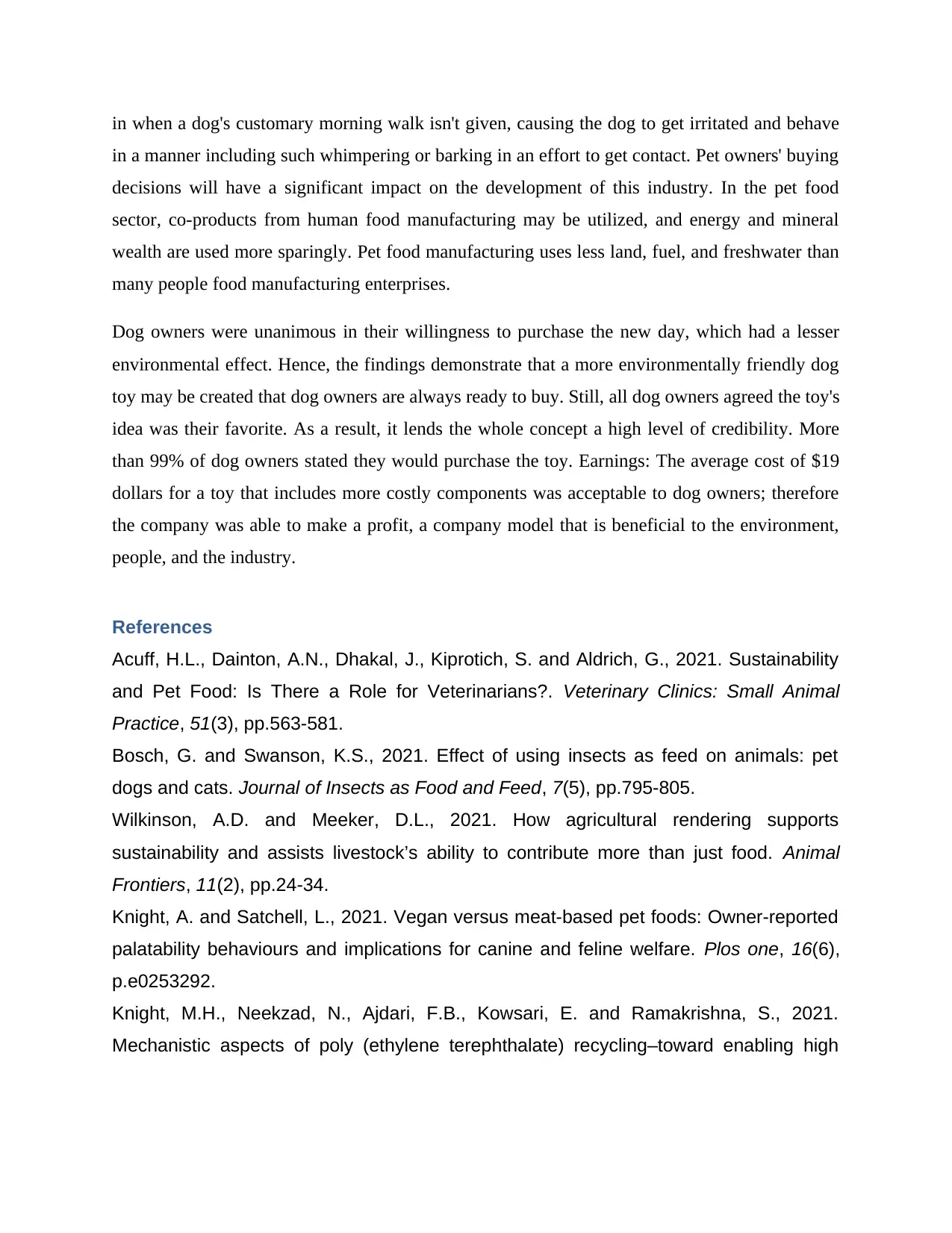
in when a dog's customary morning walk isn't given, causing the dog to get irritated and behave
in a manner including such whimpering or barking in an effort to get contact. Pet owners' buying
decisions will have a significant impact on the development of this industry. In the pet food
sector, co-products from human food manufacturing may be utilized, and energy and mineral
wealth are used more sparingly. Pet food manufacturing uses less land, fuel, and freshwater than
many people food manufacturing enterprises.
Dog owners were unanimous in their willingness to purchase the new day, which had a lesser
environmental effect. Hence, the findings demonstrate that a more environmentally friendly dog
toy may be created that dog owners are always ready to buy. Still, all dog owners agreed the toy's
idea was their favorite. As a result, it lends the whole concept a high level of credibility. More
than 99% of dog owners stated they would purchase the toy. Earnings: The average cost of $19
dollars for a toy that includes more costly components was acceptable to dog owners; therefore
the company was able to make a profit, a company model that is beneficial to the environment,
people, and the industry.
References
Acuff, H.L., Dainton, A.N., Dhakal, J., Kiprotich, S. and Aldrich, G., 2021. Sustainability
and Pet Food: Is There a Role for Veterinarians?. Veterinary Clinics: Small Animal
Practice, 51(3), pp.563-581.
Bosch, G. and Swanson, K.S., 2021. Effect of using insects as feed on animals: pet
dogs and cats. Journal of Insects as Food and Feed, 7(5), pp.795-805.
Wilkinson, A.D. and Meeker, D.L., 2021. How agricultural rendering supports
sustainability and assists livestock’s ability to contribute more than just food. Animal
Frontiers, 11(2), pp.24-34.
Knight, A. and Satchell, L., 2021. Vegan versus meat-based pet foods: Owner-reported
palatability behaviours and implications for canine and feline welfare. Plos one, 16(6),
p.e0253292.
Knight, M.H., Neekzad, N., Ajdari, F.B., Kowsari, E. and Ramakrishna, S., 2021.
Mechanistic aspects of poly (ethylene terephthalate) recycling–toward enabling high
in a manner including such whimpering or barking in an effort to get contact. Pet owners' buying
decisions will have a significant impact on the development of this industry. In the pet food
sector, co-products from human food manufacturing may be utilized, and energy and mineral
wealth are used more sparingly. Pet food manufacturing uses less land, fuel, and freshwater than
many people food manufacturing enterprises.
Dog owners were unanimous in their willingness to purchase the new day, which had a lesser
environmental effect. Hence, the findings demonstrate that a more environmentally friendly dog
toy may be created that dog owners are always ready to buy. Still, all dog owners agreed the toy's
idea was their favorite. As a result, it lends the whole concept a high level of credibility. More
than 99% of dog owners stated they would purchase the toy. Earnings: The average cost of $19
dollars for a toy that includes more costly components was acceptable to dog owners; therefore
the company was able to make a profit, a company model that is beneficial to the environment,
people, and the industry.
References
Acuff, H.L., Dainton, A.N., Dhakal, J., Kiprotich, S. and Aldrich, G., 2021. Sustainability
and Pet Food: Is There a Role for Veterinarians?. Veterinary Clinics: Small Animal
Practice, 51(3), pp.563-581.
Bosch, G. and Swanson, K.S., 2021. Effect of using insects as feed on animals: pet
dogs and cats. Journal of Insects as Food and Feed, 7(5), pp.795-805.
Wilkinson, A.D. and Meeker, D.L., 2021. How agricultural rendering supports
sustainability and assists livestock’s ability to contribute more than just food. Animal
Frontiers, 11(2), pp.24-34.
Knight, A. and Satchell, L., 2021. Vegan versus meat-based pet foods: Owner-reported
palatability behaviours and implications for canine and feline welfare. Plos one, 16(6),
p.e0253292.
Knight, M.H., Neekzad, N., Ajdari, F.B., Kowsari, E. and Ramakrishna, S., 2021.
Mechanistic aspects of poly (ethylene terephthalate) recycling–toward enabling high
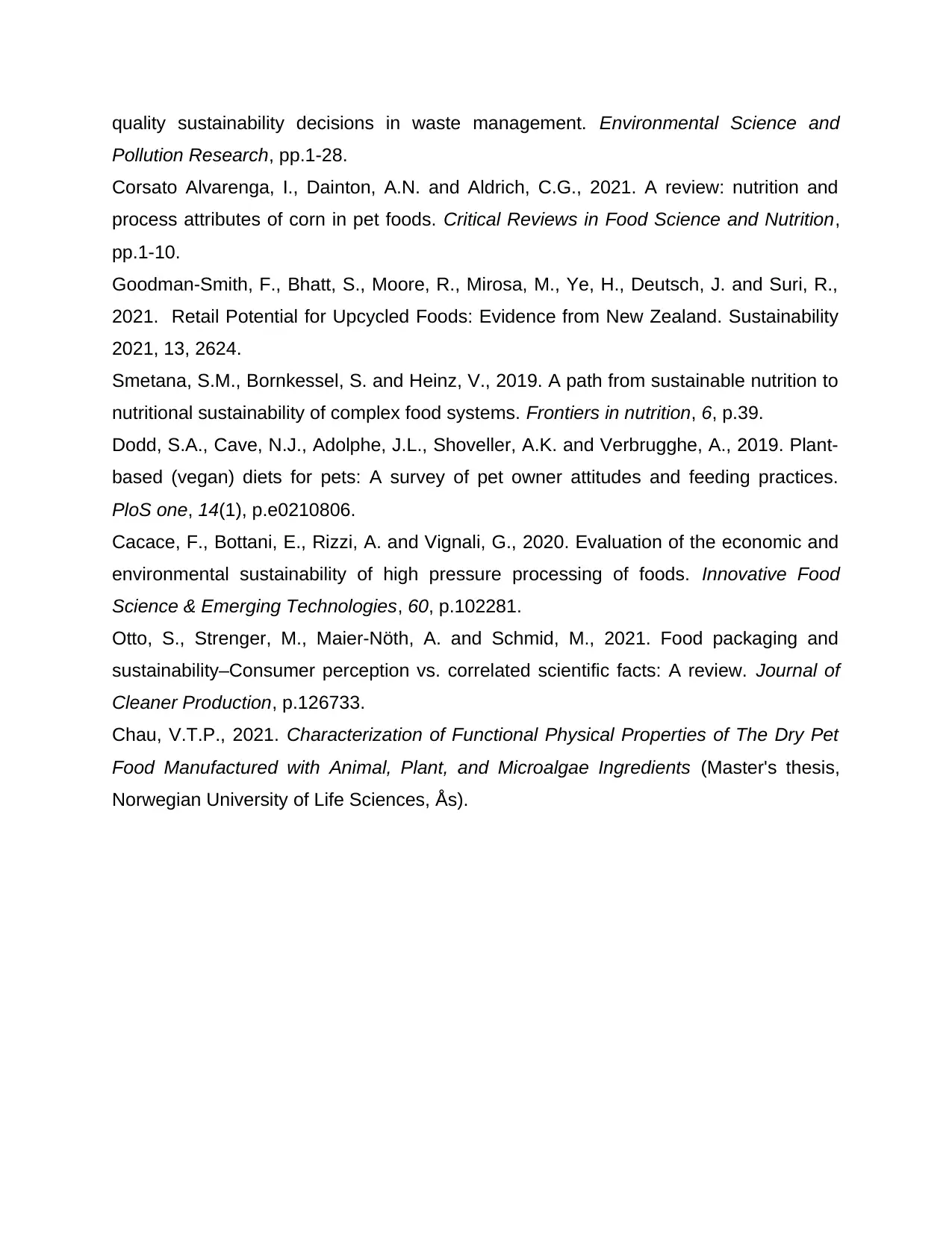
quality sustainability decisions in waste management. Environmental Science and
Pollution Research, pp.1-28.
Corsato Alvarenga, I., Dainton, A.N. and Aldrich, C.G., 2021. A review: nutrition and
process attributes of corn in pet foods. Critical Reviews in Food Science and Nutrition,
pp.1-10.
Goodman-Smith, F., Bhatt, S., Moore, R., Mirosa, M., Ye, H., Deutsch, J. and Suri, R.,
2021. Retail Potential for Upcycled Foods: Evidence from New Zealand. Sustainability
2021, 13, 2624.
Smetana, S.M., Bornkessel, S. and Heinz, V., 2019. A path from sustainable nutrition to
nutritional sustainability of complex food systems. Frontiers in nutrition, 6, p.39.
Dodd, S.A., Cave, N.J., Adolphe, J.L., Shoveller, A.K. and Verbrugghe, A., 2019. Plant-
based (vegan) diets for pets: A survey of pet owner attitudes and feeding practices.
PloS one, 14(1), p.e0210806.
Cacace, F., Bottani, E., Rizzi, A. and Vignali, G., 2020. Evaluation of the economic and
environmental sustainability of high pressure processing of foods. Innovative Food
Science & Emerging Technologies, 60, p.102281.
Otto, S., Strenger, M., Maier-Nöth, A. and Schmid, M., 2021. Food packaging and
sustainability–Consumer perception vs. correlated scientific facts: A review. Journal of
Cleaner Production, p.126733.
Chau, V.T.P., 2021. Characterization of Functional Physical Properties of The Dry Pet
Food Manufactured with Animal, Plant, and Microalgae Ingredients (Master's thesis,
Norwegian University of Life Sciences, Ås).
Pollution Research, pp.1-28.
Corsato Alvarenga, I., Dainton, A.N. and Aldrich, C.G., 2021. A review: nutrition and
process attributes of corn in pet foods. Critical Reviews in Food Science and Nutrition,
pp.1-10.
Goodman-Smith, F., Bhatt, S., Moore, R., Mirosa, M., Ye, H., Deutsch, J. and Suri, R.,
2021. Retail Potential for Upcycled Foods: Evidence from New Zealand. Sustainability
2021, 13, 2624.
Smetana, S.M., Bornkessel, S. and Heinz, V., 2019. A path from sustainable nutrition to
nutritional sustainability of complex food systems. Frontiers in nutrition, 6, p.39.
Dodd, S.A., Cave, N.J., Adolphe, J.L., Shoveller, A.K. and Verbrugghe, A., 2019. Plant-
based (vegan) diets for pets: A survey of pet owner attitudes and feeding practices.
PloS one, 14(1), p.e0210806.
Cacace, F., Bottani, E., Rizzi, A. and Vignali, G., 2020. Evaluation of the economic and
environmental sustainability of high pressure processing of foods. Innovative Food
Science & Emerging Technologies, 60, p.102281.
Otto, S., Strenger, M., Maier-Nöth, A. and Schmid, M., 2021. Food packaging and
sustainability–Consumer perception vs. correlated scientific facts: A review. Journal of
Cleaner Production, p.126733.
Chau, V.T.P., 2021. Characterization of Functional Physical Properties of The Dry Pet
Food Manufactured with Animal, Plant, and Microalgae Ingredients (Master's thesis,
Norwegian University of Life Sciences, Ås).
1 out of 10
Your All-in-One AI-Powered Toolkit for Academic Success.
+13062052269
info@desklib.com
Available 24*7 on WhatsApp / Email
![[object Object]](/_next/static/media/star-bottom.7253800d.svg)
Unlock your academic potential
© 2024 | Zucol Services PVT LTD | All rights reserved.
